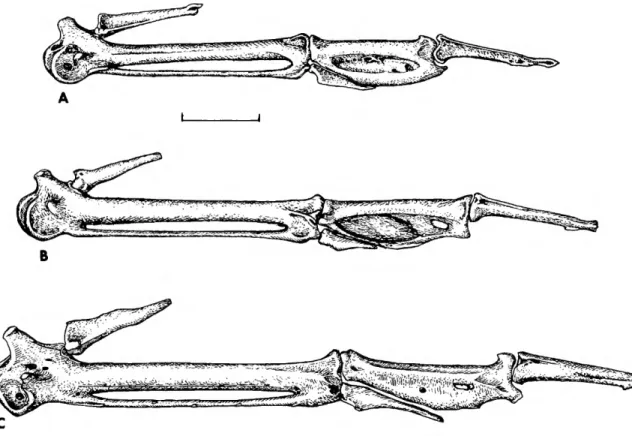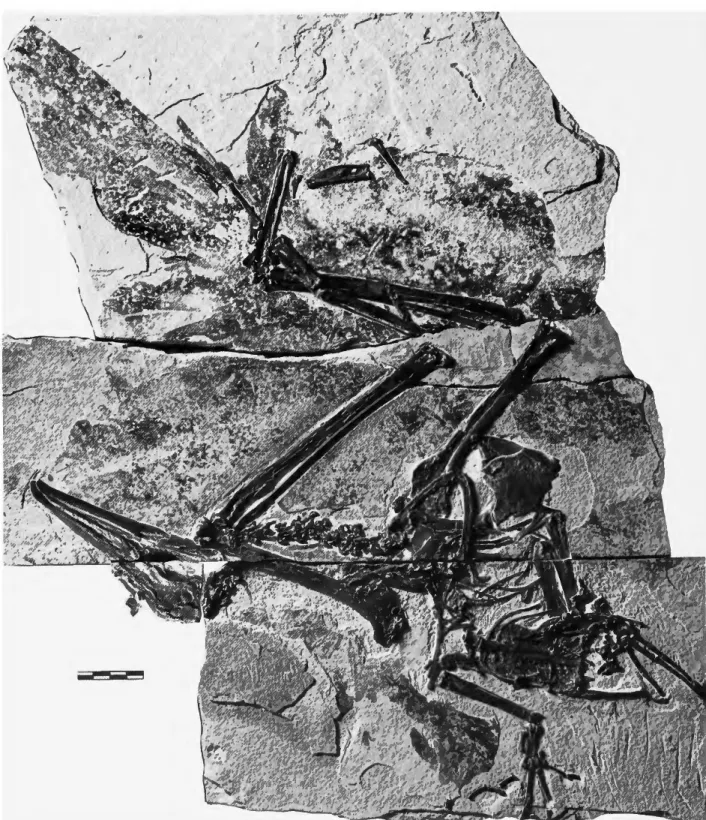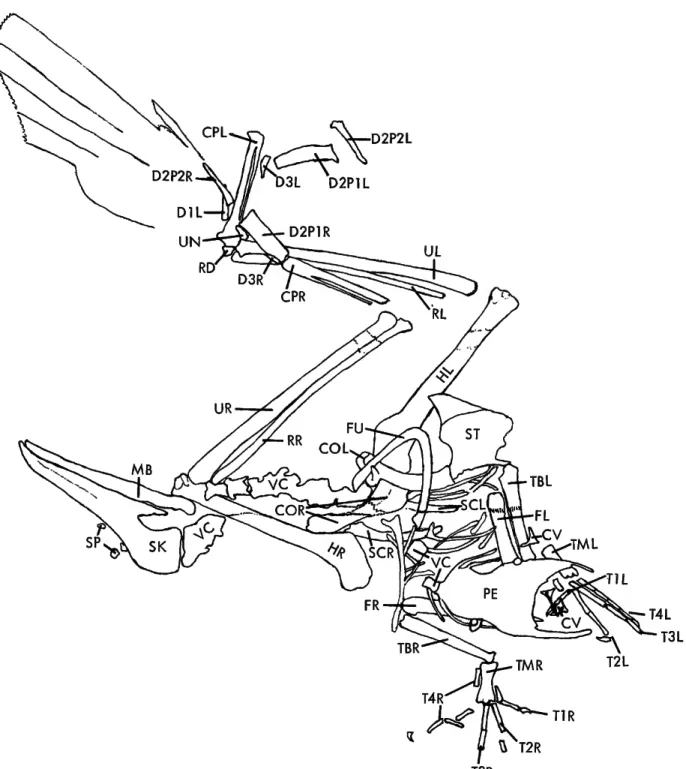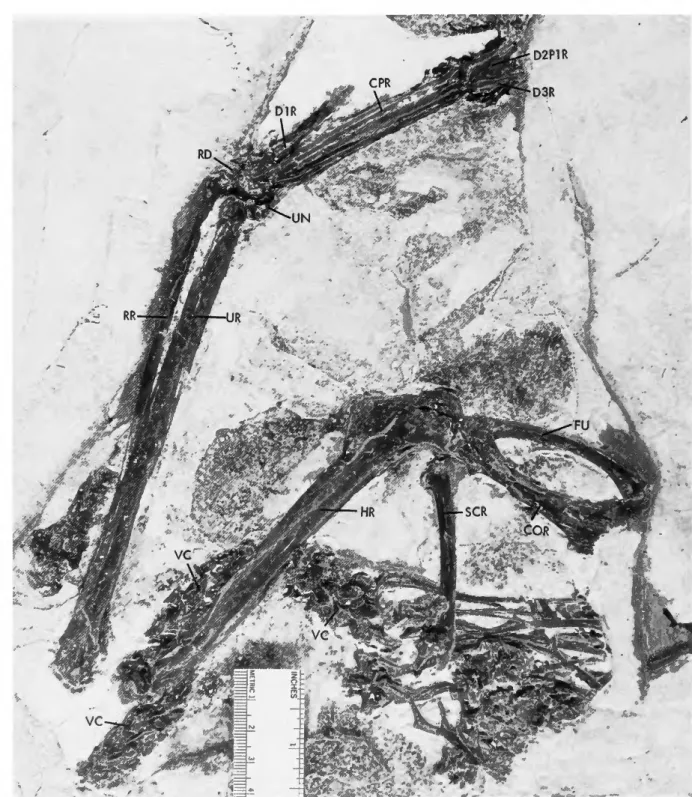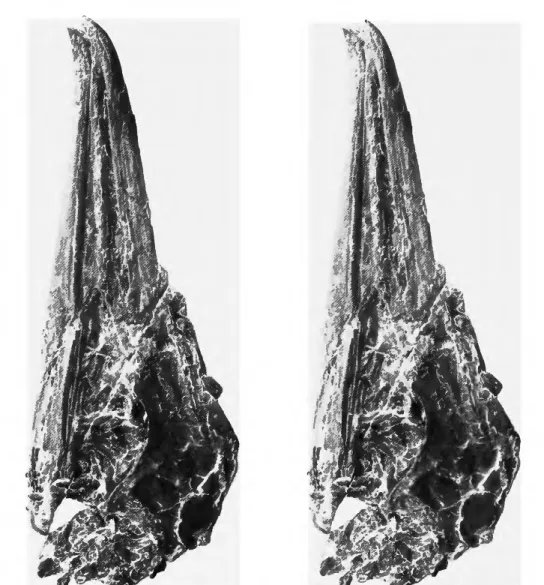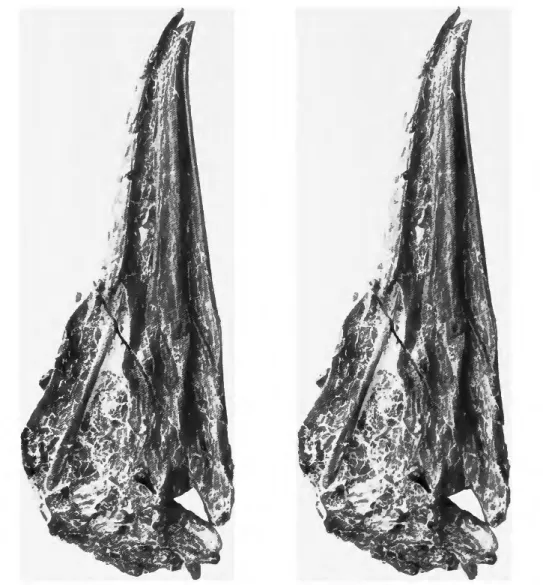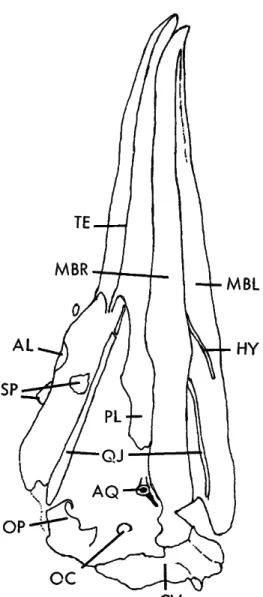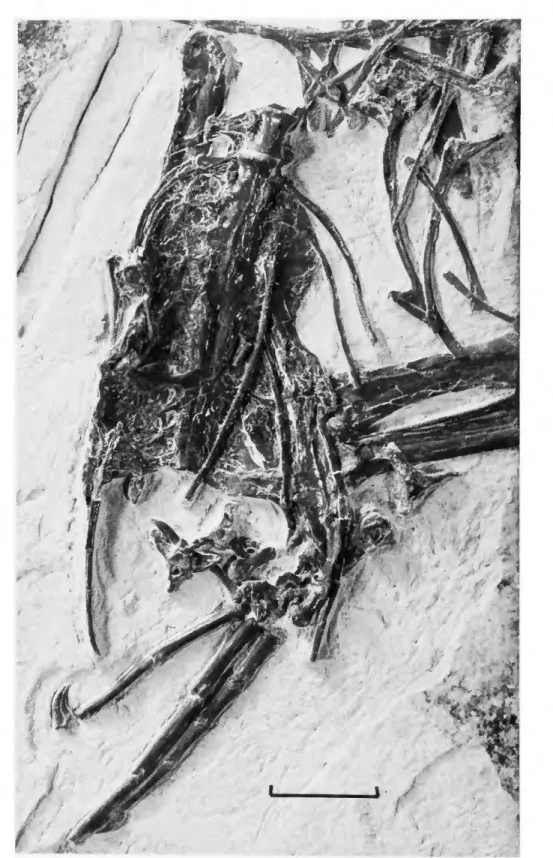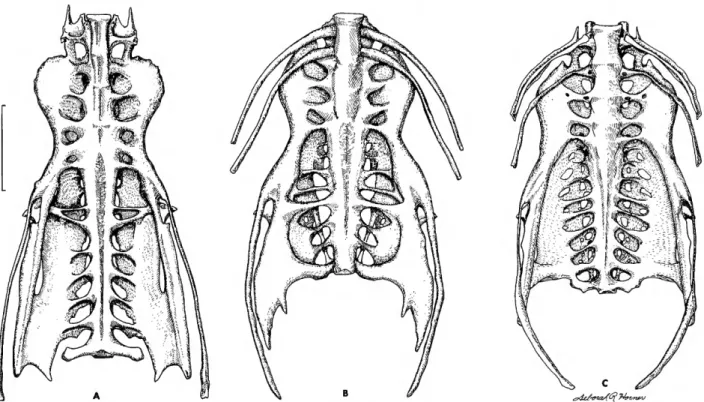ACKNOWLEDGMENTS.—The careful preparation of the holotype of the new species was undertaken by Leroy Glenn, who spent many hours on this task. Most of the skull and sternum were in smaller pieces of counterplate (Figure 1). Imprints of the alula and some primaries are clearly preserved on the right wing.
Most of the right scapula is exposed, while the left scapula, except for the last one, is covered. Also, the carina was removed from the main plate and joined to the rest of the sternum. Compared to the ulna of the holotype, however, it was found to be morphologically identical.
In ventral view, there is less ossification between the anterior parts of the palatine and the quadratojugal bar. On the front side there is a thin oblong scar for the attachment of the lacrimal gland. The lower jaw is more like a frigatebird than any other member of the order.
Like the axis, this vertebra differs from Sula in the much smaller development of the hypopophysis.
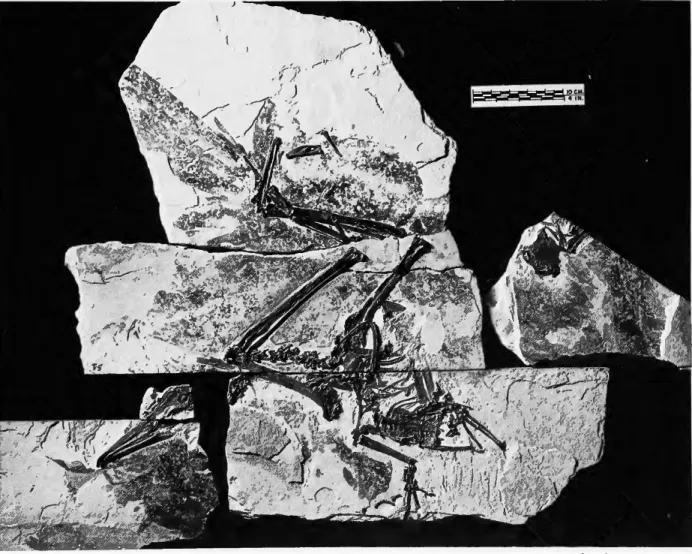
In Phaethon, the postzygapophyses of the fourth cervical line are extremely weakened, unlike in both sexes of frigatebirds. It is very similar to that of Fregata, but is proportionately shorter, with longer styloid processes and a deeper posterior surface of the center. The pelvis (Figure 10) of Limnofregata is short, wide and shallow, unlike all Pelecaniformes except Fregata and Phaethon.
In the other families of the order, the pelvis is long, laterally compressed (especially in diving forms, such as cormorants), and deep (Figure 11). Limnofregata agrees with Fregata and differs from Phaethon in the greater expansion of the preacetabular ilia into broad, r o u n d e d shields. In Fregata and Limnofregata, the sixth and seventh caudals differ from the rest of the series in having well-developed hemapophyses, which are larger in the seventh than in the sixth.
The transverse processes of the seventh coccyx are better developed in Limnofregata than in Fregata. The hemapophyses of the sixth caudus in Limnofregata are somewhat shorter and well separated, instead of being fused as in Fregata. All the caudal vertebrae of Limnofregata differ from those of Fregata in that they are not inflated and, with the exception of the 7th, have shorter and wider transverse processes.
From this we can conclude that the structure and shape of the Limnofregate's tail probably differed from that of the Frigate. This matches the deeper facet of the coracoid scapula in both genera. The ventral surface of the furcula is exposed in the holotype of Limnofregata (Fig. 12), with the entire anterior articulation obliterated on the right side and the scapular tuberosity obscured on the left.
Comparing the furcula of Limnofregata with that of Fregata is difficult, because in the latter this bone is broadly fused posteriorly with the sternum and anteriorly with the coracoid, whereas in Limnofregata there is no such fusion. Despite the fact that it is not fused to the rest of the pectoral ring, the furcula of Limnofregata appears to be more similar to that of Fregata than to other members of the order. The sternum of the holotype of Limnofregata is well preserved and is visible in the ventrolateral aspect of the left side (Fig. 16).
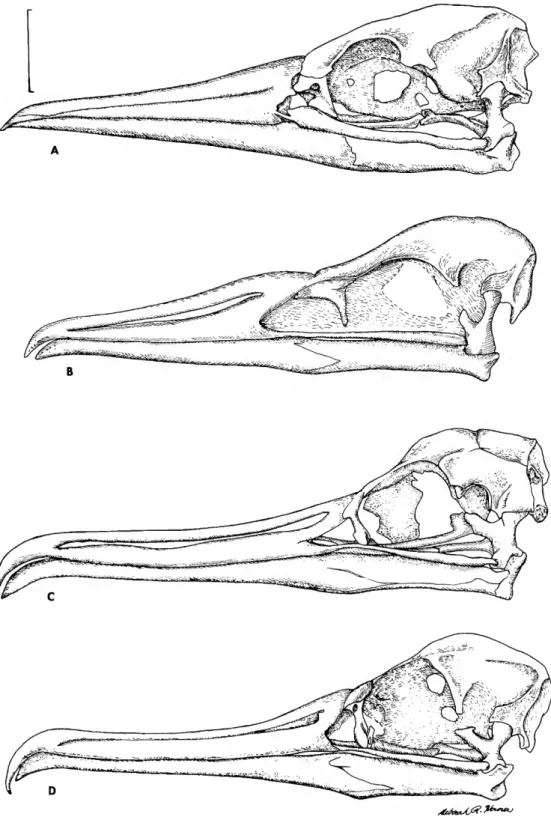
T he posterior margin of the sternum in Limnofregata is decidedly 4-notched, the lateral notch on each side is rather deep and the posterior lateral processes are slender and elongate. Phaethon also has a 4-notched sternum, but in this genus the medial notches are the larger and the lateral ones much reduced, sometimes to different degrees on either side of the same individual. T he sternum in Limnofregata is certainly closer to that of Fregata than to any other modern genus of the order.
T h e h u m e r u s of Limnofregata (Figure 18) resemble Phaethon and Fregata and differ from any of the Pelecani in having a large triangular deltoid crest. The shaft appears to have been relatively stronger than in Fregata or Phaethon, but this may partly be due to distortion of the fossil specimens. This scar is less evident in Phaethon and is located off the midline, more toward the deltoid crest, as is the condition in the other modern members of the Pelecaniformes where this scar is evident at all.
The distal end of the humerus in Limnofregata differs considerably from that of Fregata a n d is more similar to that of Phaethon or even Sula. The frigate differs in possessing a highly inflated, elongate ridge extending proximally from the entepicondylar prominence, in the greater development of the ectepicondylar area, a n d in the more bulbous and inflated outer condyle, which lacks the slight hook at the proximal end is seen in Limno- frigate. Limnofregata differs from Phaethon a n d Sula a n d is closer to Fregata in its greater attachment of the anterior articular ligament a n d greater development of the ectepicondylar area.
The papillae for the secondaries are not nearly as well developed as in Fregata (Fig. 21), although it appears that the inner surface of the stem was probably more rounded than in Fregata, rather than being somewhat flattened. The most distinctive feature of the ulna of Limnofregata is the very large, roughly triangular protuberance behind the anterior articular ligament (Fig. 22), which has a tapered extension along the lower edge of the impression of M. The distal end of the ulna in Limnofregata is quite similar to that of Fregata and differs markedly from Phaethon, in in which the carpal tubercle is large and hooked and bears a deep groove between it and the internal condyle.
Limnofregata's radius is more sharply triangular in cross-section than that of Fregata and therefore more closely resembles Phaethon. The left ulnar of the holotype is seen mainly in its internal aspect, and it has a senerille much deeper than in either Fregata or Sula b u t, which is similar to that seen in Phaethon. The proximal end is not as widened and protrudes more distinctly from the shaft in Limnofregata than in Fregata.
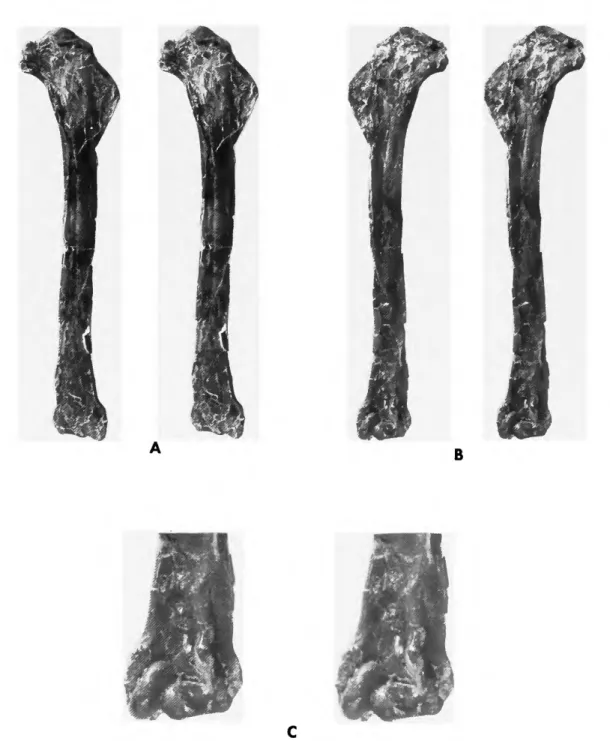
The femora of the holotype of Limnofregata azy-gosternon are somewhat difficult to interpret because both are partially indistinct. By having the head flat and lying below the level of the trochanter, Limnofregata differs from Phaethon and all Pelecani and agrees only with Fregata (Figure 25). The femur of Limnofregata differs from that of Fregata in that it is proportionally longer, in that the attachment of the ligamentum teres is deeper and more distinct, and in the slightly greater development of the fibular condyle.
The distal end of the tibiotarsus in Limnofregata is similar to that of Fregata and differs from the other genera in having a distinct internal ligamentous process. Viewed from the front, the inner and outer condyles in Limnofregata are roughly triangular, with the apex of the triangles pointing toward the midline. Seen from behind, the apex of the inner condyle is better developed than in Sula or Phaethon and more closely resembles the condition in Fregata.
The distal foramen is well developed and circular in Limnofregata and opens onto the posterior surface of the shaft, and is similar in all respects to Sula, although relatively smaller. Limnofregata provides some new information about the affinities of the Fregatidae, as it provides us with a frigate bird without many of the obscuring specializations of Fregata. The latter is undoubtedly a primitive character and most or all of the others may be as well.
Note that the body size of the two species is virtually the same, as evidenced by the length of the sternum and pelvis. Although the hindlimb of Fregata is shorter than that of Limnofregata, that of the latter shows that by the early Eocene the hindlimb of frigatebirds had already become shorter than that of other Pelecaniformes. These include wing elongation, fusion of the pectoral girdle, and extensive skeletal pneumatization.
The fact that they also differ from Limnofregata is not particularly problematic when assessing the fossil's relationship. From its structure, one can surmise that Limnofregata probably occupied a niche similar to that of modern gulls of the genus Larus. Synonyms in the zoology and paleobiology series should use the short f o r m (taxon, author, year:page), with a full reference at the end of the paper under "Literature Cited.".
Footnotes, if few in number, annotative or bibliographical, should be typed at the bottom of the text page on which the reference appears. 34; For alignment and arrangement of elements, follow the format of the series for which the manuscript is intended.
